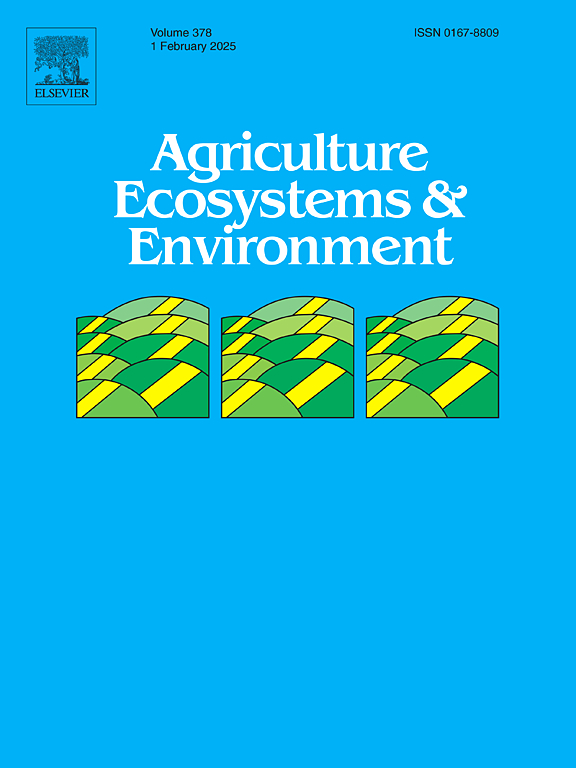在花期结束的人为环境中,入侵植物是多种传粉媒介重要的补充食物资源
IF 6
1区 农林科学
Q1 AGRICULTURE, MULTIDISCIPLINARY
引用次数: 0
摘要
水草是欧洲入侵速度最快的植物之一,在各种人为生境中形成大型开花林。这种植物富含花蜜和花粉,从5月下旬到冬季开始开花,因此为适应其存在的传粉者提供了食物来源作为竞争优势。然而,花粉和花蜜中含有的吡咯利西啶生物碱的产生也构成了威胁。我们提出了以下问题:1)模式入侵物种是否被用作传粉媒介的食物资源?2)入侵物种融入植物-传粉者群落的时空格局如何影响这一系统?3)入侵模式物种的花毒素是否会对传粉者的适合度产生负面影响?我们提供了第一个直接的证据,证明入侵的黄叶菊和本土的黄叶菊是广泛的访花动物的补充食物资源,包括食蚜蝇、蜜蜂、大黄蜂和独居蜜蜂。如果周围的人为景观提供了足够的筑巢资源和其他补充食物来源,它们的丰度和物种丰富度会特别高。其他植物物种在开花期间胜过这两种塞尼科植物。传粉者从Senecioneae科转向或转向,与其他丰富的食物资源的开花时期的开始或结束相对应。用含有丰富的花粉提取物的花粉饲喂多电蛾幼虫,可显著降低其变态成功率,但对其体型和对称性没有影响。因此,入侵秋花植物是人为环境中多种传粉媒介的重要补充食物资源。本文章由计算机程序翻译,如有差异,请以英文原文为准。
Invasive plant serves as an important complementary food resource for diverse pollinators in anthropogenic environments at the end of the flowering season
Senecio inaequidens is one of Europe’s fastest plant invaders, which forms large flowering stands in various anthropogenic habitats. This plant is nectar- and pollen-rich and flowers from late May until the beginning of winter, thus providing food sources as a competitive advantage for pollinators that adapt to its presence. However, it also poses a threat in the form of the production of pyrrolizidine alkaloids that are contained in the pollen and nectar. We asked the following questions: 1) Is the model invasive species used as a food resource for pollinators? 2) How do the spatio-temporal patterns of invasive species’ integration into plant-pollinator communities affect this system? 3) Do the floral toxins of the invasive model species cause a negative impact on the fitness of pollinators? We provide the first direct evidence that invasive Senecio inaequidens and native Jacobaea vulgaris serve as complementary food resources for a broad spectrum of flower visitors, including hoverflies, honey bees, bumblebees, and solitary bees. Their abundance and species richness are particularly high if the surrounding anthropogenic landscape provides sufficient nesting resources and other complementary food sources. Other plant species outcompete the two Senecioneae spp. during their flowering period. The pollinators switched to and from Senecioneae spp., corresponding to the beginnings or ends of flowering periods of other abundantly present food resources. Feeding larvae of the polylectic Osmia species with pollen enriched with extracts from Senecioneae spp. inflorescences led to significant decreases in metamorphosis success rates but did not affect body dimensions or symmetry. Therefore, the invasive autumn-flowering plant Senecio inaequidens is an important complementary food resource for diverse pollinators in anthropogenic environments.
求助全文
通过发布文献求助,成功后即可免费获取论文全文。
去求助
来源期刊

Agriculture, Ecosystems & Environment
环境科学-环境科学
CiteScore
11.70
自引率
9.10%
发文量
392
审稿时长
26 days
期刊介绍:
Agriculture, Ecosystems and Environment publishes scientific articles dealing with the interface between agroecosystems and the natural environment, specifically how agriculture influences the environment and how changes in that environment impact agroecosystems. Preference is given to papers from experimental and observational research at the field, system or landscape level, from studies that enhance our understanding of processes using data-based biophysical modelling, and papers that bridge scientific disciplines and integrate knowledge. All papers should be placed in an international or wide comparative context.
 求助内容:
求助内容: 应助结果提醒方式:
应助结果提醒方式:


